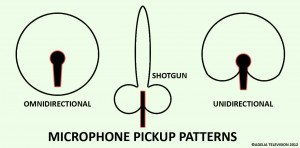BASICS 4: AUDIO
Our final tutorial on camera settings addresses audio – the one area a lot of newbies forgets to spend enough time on.
I would argue that audio makes up 50% of our AV experience. Certainly bad focus, exposure and white balance can usually be compensated for in post production but bad audio can be very difficult to fix afterwards.
It is important to set your audio levels manually and to wear headphones. It is also important to use the right microphones.
Mics all have different pick up patterns and pick up sizes. These are some of the popular ones – no giggling please…
As you can see the two fist microphones either side have slightly different pickup patterns.
The unidirectional microphone on the right is traditionally used by musicians so they don’t get feedback from the speakers in live situations.
The omnidirectional microphone on the left is used by reporters. This type of reporters microphone is used all over the world and generally has a ‘flag’ on it – a box that fits around the microphone with the television stations logo on it. This type of microphone gets the best quality sound from whatever is closest to it no matter what direction. This means it is great for interviews as if it is held between two people it will pick them up in preference to other sounds that are further away and it doesn’t matter what direction the microphone is pointing.
The microphone in the middle (stop giggling) is usually called the shotgun mic, however, it has many names:
- Gun
- Rifle
- Pistol Grip
- Dog
- Dougal
As you can see, all the names are either gun related due to the way you hold the microphone or dog related due to the fluffy cover used to prevent wind noise!
This type of microphone (I call it a dougal) has a very long thin pickup up pattern – the diagrams are not to scale and this microphone picks up over a much larger distance than the other two. It is highly directional, and although it won’t pick up a whisperer at 20 metres in preferences to a shouter right next to it, there is a large amount of discrimination depending on the direction it is pointed.
In Britain we almost always use a shotgun microphone – it is held out of shot and its long and discriminatory pick up pattern is used to full advantage.
In news, around the world the reporters microphone or fist mic is more commonly used for several reasons:
- It is almost foolproof when in the hands of a journalist!
- It is an advertising platform!
- It is much, much cheaper…
Whichever type of microphone you decide to use you need to wear headphones in cheap for crackly cables / electrical interference and to check that your microphone is picking up the sound you want it to.
You also need to set the audio levels so that they are not too quiet, or too loud and start distorting. On a professional camera you will be able to see level meters either in the viewfinder or on the side of the camera – make sure you have a healthy average level and that it does not peak too often…
AUTO LEVELS
Auto levels are usually a bad idea – if you are recording by a road the camera will turn all the volume down for a loud lorry and you will lose the sound of your interviewee as well. As per focus, exposure, and white balance, auto sound levels will compromise and continually adjust. You need to take control and make sure that what you hear in your headphones is what you need to take home…
If you have to use auto levels find somewhere quiet and:
- ‘move’ camera or location until the camera gives you good audio
- ‘don’t move’ once recording to prevent the levels changing mid shot
Leave a comment
Categories
Tutorials
Or maybe, wanting to jog your memory on a few key points?
Well here in Tutorials we'll walk you through how to consistently capture professional quality video whatever camera you are holding.
Start at the top - these posts are sorted for you to work through from top to bottom...






